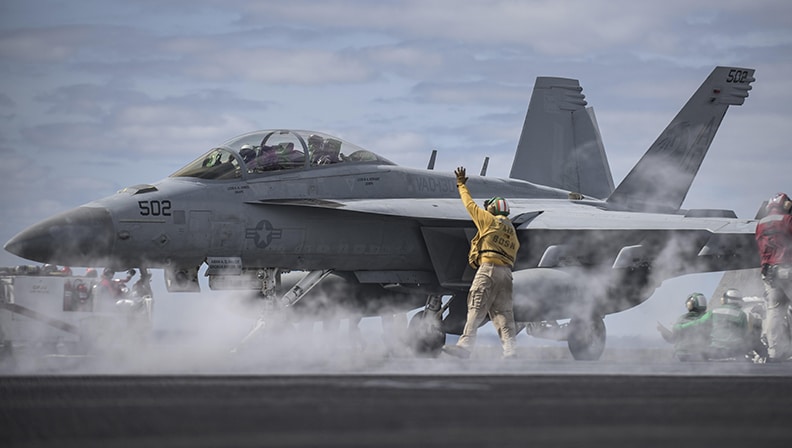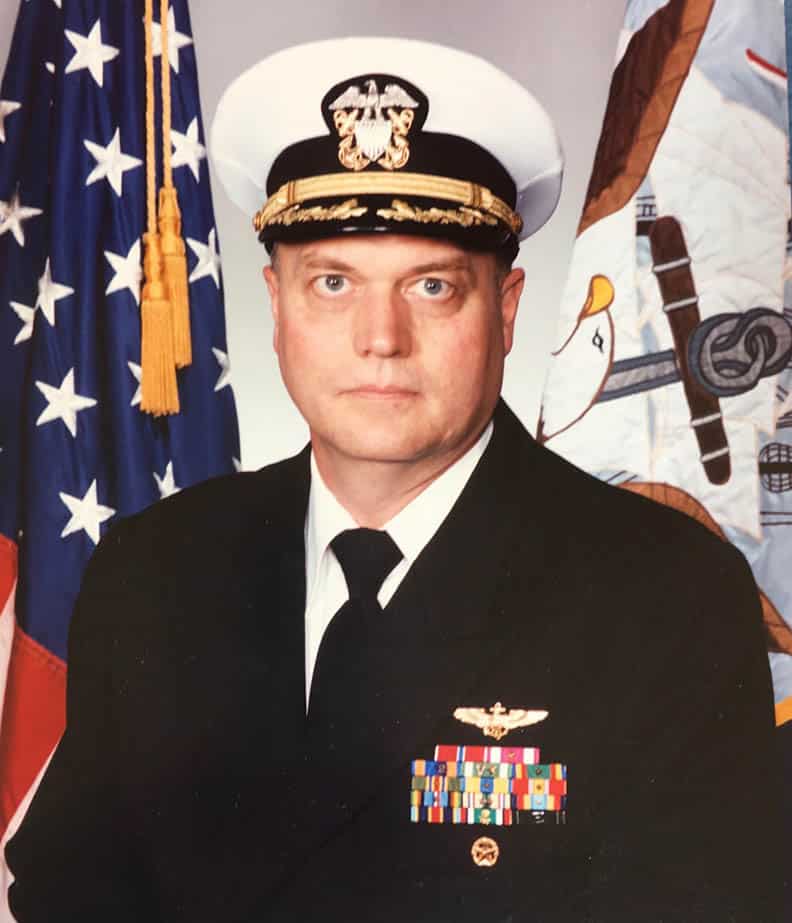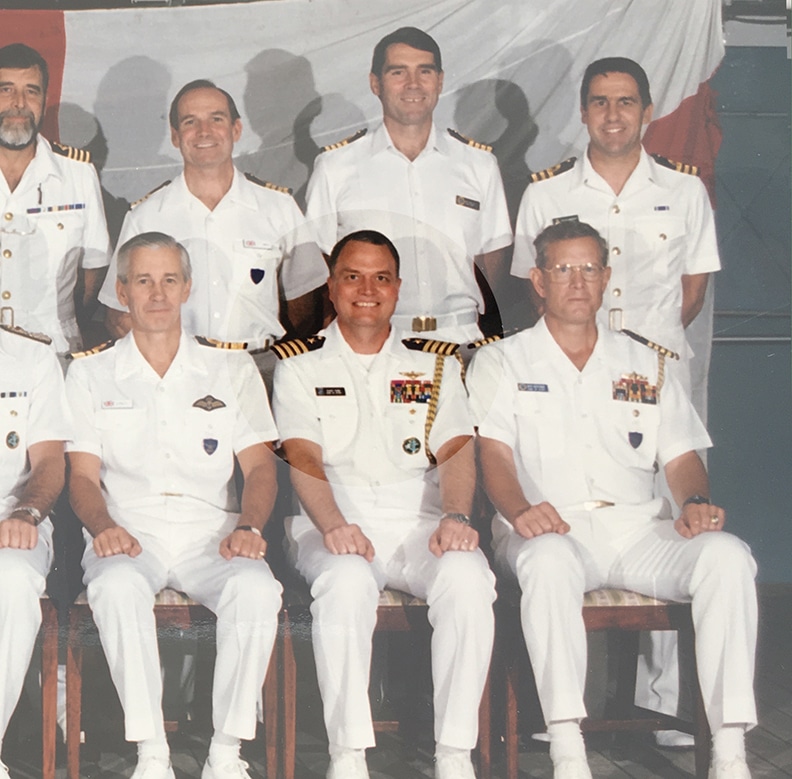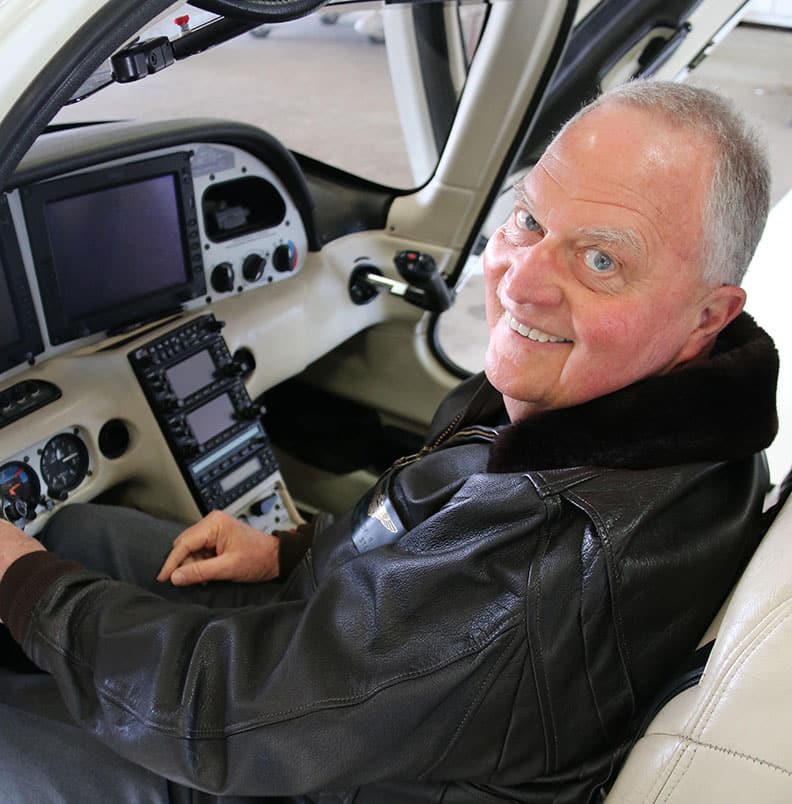Former Navy captain and fighter pilot Randy Robb
By Scott E. Raymond

Wearing his Navy flight jacket, Randy is standing beside a U.S. Navy T-6 that landed at Chennault for refueling. Photo By Peter O’Carroll
When Randy Robb watches a pilot perform aerobatics at an airshow, it’s probably safe to say his mind is keenly in tune with the pilot’s as he looks up at the sky, eagerly anticipating the aircraft’s next thrilling maneuver.
United States Navy Capt. Randy Robb, (ret.) — former fighter pilot, commanding officer and Desert Storm combat veteran — has been in the pilot’s cockpit countless times in the most demanding situations.
As a boy growing up in Arlington, Texas, Robb seemed destined to someday forge a Navy career. His father, a World War II veteran, was employed with LTV (formerly, Ling-Temco-Vought) as an electronics technician, working on such military aircraft of the time as the Vought F-8 Crusader and the LTV A-7 Corsair II.
“Of course, I flew the Corsair II!” Robb, tall and fit, eagerly points out.
“My dad was an electronics technician in the high speed wind tunnel,” Robb says proudly of his father. “So he worked on the F-8s and A-7s.”

Robb flew F/A-18 Hornet missions during Operation Desert Storm in 1991 from the carrier USS Midway (CV-41).
“When I was a young kid,” he says, “NAS (Naval Air Station) Dallas [had] Blue Angels airshows when they were flying (Grumman) F-9 (Cougars). He would take me there every time they had one.”
Robb’s mother sold advertising for the local newspaper in Arlington. He grew up with one sibling, a sister. “[My sister and I] do a lot of stuff together still,” he says fondly.
Robb says he never thought much about being in the military, let alone a pilot. But in 1972, something happened to him that forced a decision as to what would become a most rewarding career.
“The (United States military) draft is what (forced) me to join the Navy,” Robb says.
“I wasn’t planning to be in the military. I got drafted. I was told to report for my physical and I (told myself) I better find something that I want to do. I went to the Air Force, the Marines and the Navy (recruiting offices), and the Navy could get me in quicker, so I joined the Navy. And I found out that I … had a knack for it. So I kind of hung out,” he said with a smile.
In Robb’s office, it’s clear that he hung out with the Navy. Many of the most impressive paintings, illustrations, photos and other memorabilia in the spacious room are related to his storied, 28-year Navy career.
Navy Officer Training
Robb begins telling about his career in the Navy with an overview of the comprehensive training he received prior to joining the fleet as a pilot.
“I went to AOCS — Aviation Officers Candidate School — in Pensacola (Fla.), and you never knew whether you were going to make that cut. And then you went to primary training in Pensacola, and you had to finish the initial training. (That training) was in T-34s (Beechcraft T-34 Mentor military trainer aircraft) before they would actually make you an officer.
“Well, I finished the T-34s and became an ensign. That was in January, 1973.
“Then I went to Meridian, Miss., for T-2 (North American T-2 Buckeye) intermediate training. I didn’t know if I was going to stay, because half-way through the first training in T-34s, the draft went away and half my class just left. Once you had the 124 days in the service, you had met your military obligation and you could leave.

Robb during his assignment to the aircraft carrier USS Saratoga (CV-60) as its executive officer.
Photo courtesy of Randy Robb
“I had nowhere to go and I thought flying T-34s was kind of fun. (I stayed) for T-2s.
“Then (the Navy) sent me to Kingsville, Texas, for (Douglas) TA-4s (Skyhawk training), and, for whatever reason, I seemed to have a knack for this, so I stuck around for the next thing.
“Then I was selected for what I asked for: A-7s. My dad was involved in that process (working on A-7s), so I went to Fleet Replacement Squadron in Jacksonville, Fla. — (which) my family calls home — to what they call the FRS: the Fleet Replacement Squadron. And (I) learned how to fly A-7s.
“(I) went to my first fleet squadron on the USS John F. Kennedy (CV-67) as an ensign. They had just extended the term for ensign from one year to two years, so, (I believe), I was the first ensign (pilot) in the (Navy) fleet since World War II.
“I had almost 100 landings on the carrier before I made lieutenant junior grade. That’s how (my Navy career) got started.”
Fighter Pilot…Squadron CO… Carrier XO/CO
The years of meticulous pilot training Randy Robb experienced paid off in a big way when he was ordered to take part in and lead combat missions.
“We did the Libya raids in ’87,” he says. “Then I transitioned to (McDonnell Douglas) F/A-18s (Hornets) and my first tour in F/A-18s. (I was) the CO (commanding officer) of (a) squadron (attached to the aircraft carrier USS) Midway (CV-41) in Japan.
“I was in (Operation) Desert Storm in ’91.”
In the Persian Gulf, with a squadron of F/A-18s launched from the steaming catapults of the Midway’s precision-run flight deck, Robb led a fraternity of young pilots to war.
“We had a bunch of happy-go-lucky kids in our squadron — a little bit different than the East Coast (pilots),” he says. “It was interesting to see because we knew that war was going to occur. So you brief your kids, and for the first time I saw some real serious looks on people’s faces.
“I had already done some Libya stuff, so I knew what surface-to-air missiles looked like. One of the young officers in the squadron had (been in combat). It was an interesting dynamic, taking a group of these kids to war for the first time. Even the sailors were worried because it’s a threat to the carriers too out there. You had to manage that dynamic as well.”
Robb says the missions he led went well. He says they did major damage to the enemy, and he didn’t lose anyone in his squadron.
“The plan (in Desert Storm) was so good that we really didn’t see much of any enemy,” Robb says. “It wasn’t a real high-threat theater because we had them so goofed up. Every time they turned their radar on, we blew it up.

Robb oversaw the completion of a shipyard in the Grand Bahamas in the early 2000’s. Photo courtesy of Randy Robb
“I look forward to waking up every day, and not too many people do that,” he says. “I always wanted the public to see how amazing carrier operations are. The general public doesn’t know what it takes to pull off a (combat mission).”
Later in his Navy career, Robb was assigned to the aircraft carrier USS Saratoga (CV-60) as its executive officer (XO) — the officer who’s second in command of the ship. He says the very demanding position made him responsible for everything from the flight deck down, and that the job required an 18-hour work day.
“But it was a real rewarding (assignment),” he says. “You were in charge of the food service; all of the engineering. We did all the underway refueling from the bridge, and (I) trained a lot of ship drivers (conning officers).”
Robb served as the Saratoga’s last XO on the last deployment before the Forrestal-class super carrier was decommissioned in 1994. Due to the sudden illness of the ship’s CO, Robb says he assumed the duties of ship’s captain for a two-week period — “and, of course, I had my XO duties as well. I had a lot of great support.”
Robb met his English wife Elaine in 1977 on a port visit to England. “We continued to communicate back on another deployment, and I met up with her again. I brought her to the U.S. and we got married. We’ve been married 39 years; 40 pretty soon!” he says proudly. “We have three kids and five grandkids.
“It wasn’t easy for her,” he states, “because I was on deployment a lot.”
A Grand Opportunity In The Grand Bahamas
After 28 years in the U.S. Navy, Randy Robb retired as a captain in January, 2001. Due to the leave time he had built up, he was able to leave the service before that time. In October, 2000, he took the first job of his post-Navy career, overseeing the completion of a shipyard in the Grand Bahamas.

Robb during a deployment with the British and Australians in the mid-1990s. Photo courtesy of Randy Robb
“I retired in Miami at (U.S.) Southern Command,” says Robb, “and (I was asked by one of the cruise lines) to complete (a shipyard in the Grand Bahamas) after I retired from the military.”
Robb says that the project had already been started. But the Bahamians were not happy with the entity doing the work. So they approached him about finishing it.
“I went to the Bahamas to complete the shipyard … Long story short, we got the thing up and running because of the way we cooperated with the Bahamian people and with all the contractors and everybody like that. We got it running and we sank the dry dock, (which) was a Polish-built dry dock that the Russians had been using for submarines.
“We sank the dry dock the day before the (first cruise) ship came in,” Robb says with a smile. “(The ship) came up. And so, we thought, ‘It’ll work!’ It was hard work, because we only had two cranes on the dry dock. You use cranes a lot on ship repair. But we got it done on time; on budget; on everything.
“It was a contract job, and I went, ‘I’m outta here.’ But the Bahamian people liked me for whatever reason, and the port authority asked me to stay and run the port and the airport. That’s how I got into the airport business. I ran the harbor companies and the airport (at Grand Bahamas). (That was) prior to coming (to Chennault).”
Executive Director Of Chennault
Randy Robb assumed his duties as executive director of Chennault International Airport Authority (“Chennault”) in September, 2008.
Robb says Chennault is classified as an industrial air park; its tenants include: AAR, Northrop Grumman, Million Air, Bechtel, Habitat for Humanity Calcasieu Area and Louisiana Millwork. He says Chennault International Airport is a Part 139 Airport regulated by the Federal Aviation Administration (FAA). He works under the direction of a seven-member board of commissioners who publicly govern Chennault and provide guidance for the management and marketing of the facility.
“(Chennault International Airport) is a 139 Airport, which means we have all of the security (and) all of the other requirements that any (FAA regulated airport) — Houston or New Orleans (for example) — has. But they didn’t hire me to run an airport,” Robb quickly points out. “They hired me to create jobs. That’s my purpose here. The airport is a big deal, but that’s (only) part of why (I am here).
“The reason that Chennault is so successful, in my opinion, is simply because of the cooperation between the city, parish, state and Chennault,” says Robb. “It’s absolutely unbelievable. I’ve never seen anything like it anywhere else in the nation, and I’ve worked in other places. It’s fantastic here!”
To understand the full range of the success story that is Chennault’s, one must know its incredible backstory — the origins of what became today’s Chennault International Airport Authority.
“In the ‘80s,” says Robb, “the economy here was really suffering. You had some really forward-thinking (local and state politicians and U.S. congressmen who) had the vision to create something here. They were able to attract the Boeing Co., and the state of Louisiana built (the 1980s buildings at Chennault) for $35 million. Now, it’s worth well over $100 million. But that’s just the buildings. The complex would probably be in the billions if you attempted to replicate it. You couldn’t possibly do this for less than a few billion dollars today.
“The buildings that they built attracted Boeing — got them here. (Boeing) did the KC-135 (tanker aircraft) project here, and then they departed.
“We’re on a lease. We own some property, but the basic airport is on a lease with the city, the parish, the school board and the state — a 99-year lease with those four entities (who brought all the properties) together to try and spur the economy.
“Chennault starts (up) and Boeing comes in and (the local economy) comes up here like this” — Robb’s hand gestures upward. “Instead of these big ups and downs, it just perks along, kind of easily going up.
“(There’s) something about the diversity of income (from different industries in the local economy) that really matters,” Robb says.
According to Robb, Chennault represents $232 million a year to the local economy.
He says that Chennault partners with Sowela Technical Community College as much as possible. Sowela offers workforce preparatory programs to students and on-site workforce development.
“We’re focused on STEM (science, technology, engineering and mathematics) education,” says Robb, “because we have a quality workforce, but don’t have the numbers that we need of trained technical people. We’ve got a $15-million training complex (across the street) that looks good. (It assists us) in those academic disciplines.
“I believe that people who want to work should work, and I want to do everything in my power to get people to work.”
“We’ve got the Arts and Humanities Building. We moved properties around so we could have that. We contributed to the Student Success Center. We contributed to the lighting in the hangars for the education program. We help them out on the aviation programs; we’re part of the team on that. The advisory group — I’m on that for Sowela.
“I’ve got to make sure that they’re turning out the kind of people that these companies want … All the plants, they are desperate for people. I think (Sowela) placed 100 percent of their people from their PTEC (Process Technology Fast Track) program.”
I asked Randy Robb what he finds most rewarding about his job. “Truly, what I find rewarding is when you go out to … the community events, you see employees here who are taking part. That’s what’s rewarding to me.”
When I asked Robb if his career in the Navy was a major contributor in preparing him for ultimately assuming the duties of executive director at Chennault, he said, “The military is a real high-risk (environment), so you have to pay a lot of attention to detail. You can’t do everything, or very much of anything, by yourself. You have to figure out how to lead people; you have to figure out how to motivate them.
“What we try to do every day for Chennault — what we’ve tried to do everywhere I’ve ever been — (is make) small, incremental improvements every day. In order to do this, you’ve got to be really good at working with other people … In the Bahamas, for sure, when I was there, you had to.”
The Airshow
Several years after coming to Chennault, Robb was approached about the facility hosting an airshow. Robb accepted the challenge; a board of directors was put together with Robb as president; and the first airshow was held in 2013. Another one took place in 2015. This year’s airshow is slated for April 28-30 at Chennault.

His military aviation career is behind him, but Robb still enjoys flying for recreation.
Photo By Peter O’Carroll
Says Robb, “We needed some wholesome, family — not too expensive — entertainment. This community has really stood tall. (The airshow’s) sponsorships, the city, the parish, the port gets behind it; the businesses get behind this; and that permits us to put on an airshow very cheaply.
“An airshow costs half-a-million or more dollars. The ones we put on (do) because we have all the best performers. (Performers have) heard about the hospitality that we bring to the table … And, of course, we have the most incredible sponsors you’ve ever seen. We have the most incredible board (of directors) — a board of directors (with) incredible talents. And that board puts together the guidance for the type of air show we have here.
“Our only goal was to make a wholesome, affordable, family entertainment for the people of this region. As we’re growing, we want to have something for people to do, and we want it to be an incredible thing!”
The Community of Lake Charles/SWLA
Randy Robb concludes our conversation with some very complimentary words about the area he works and lives in.
“I gained 30 pounds (when we moved to Lake Charles)!” says Robb with a smile. “My grandparents lived in Metairie (La.), so (my sister and I) would spend the summers with them in Metairie growing up. We loved Louisiana so much.
“(While preparing for my next career move, my wife and I) were trying to either get back to Texas or Louisiana. So we were successful.
“Just being part of this community is something incredibly special. I’ve never seen anything like it anywhere, and I’ve been all across the United States. I’ve never seen anything like this community.”


















Comments are closed.